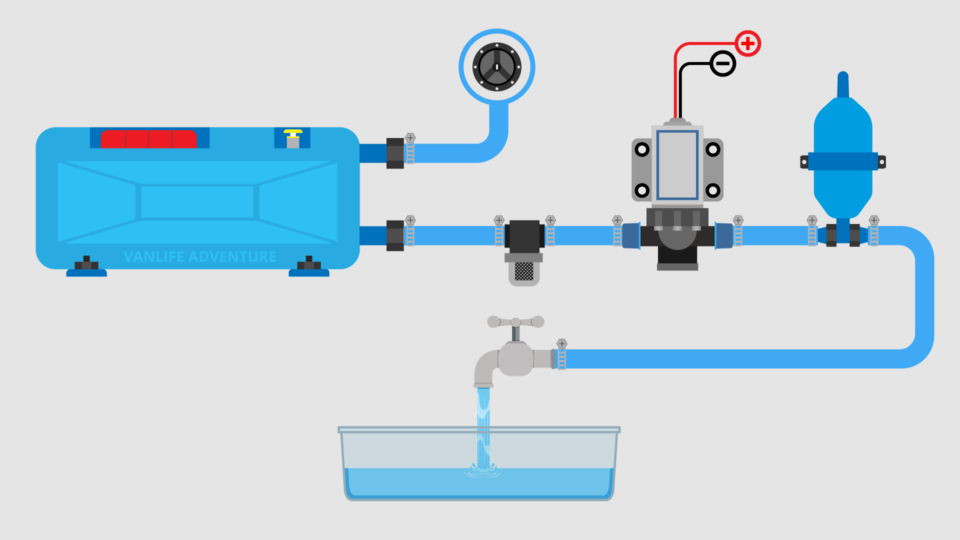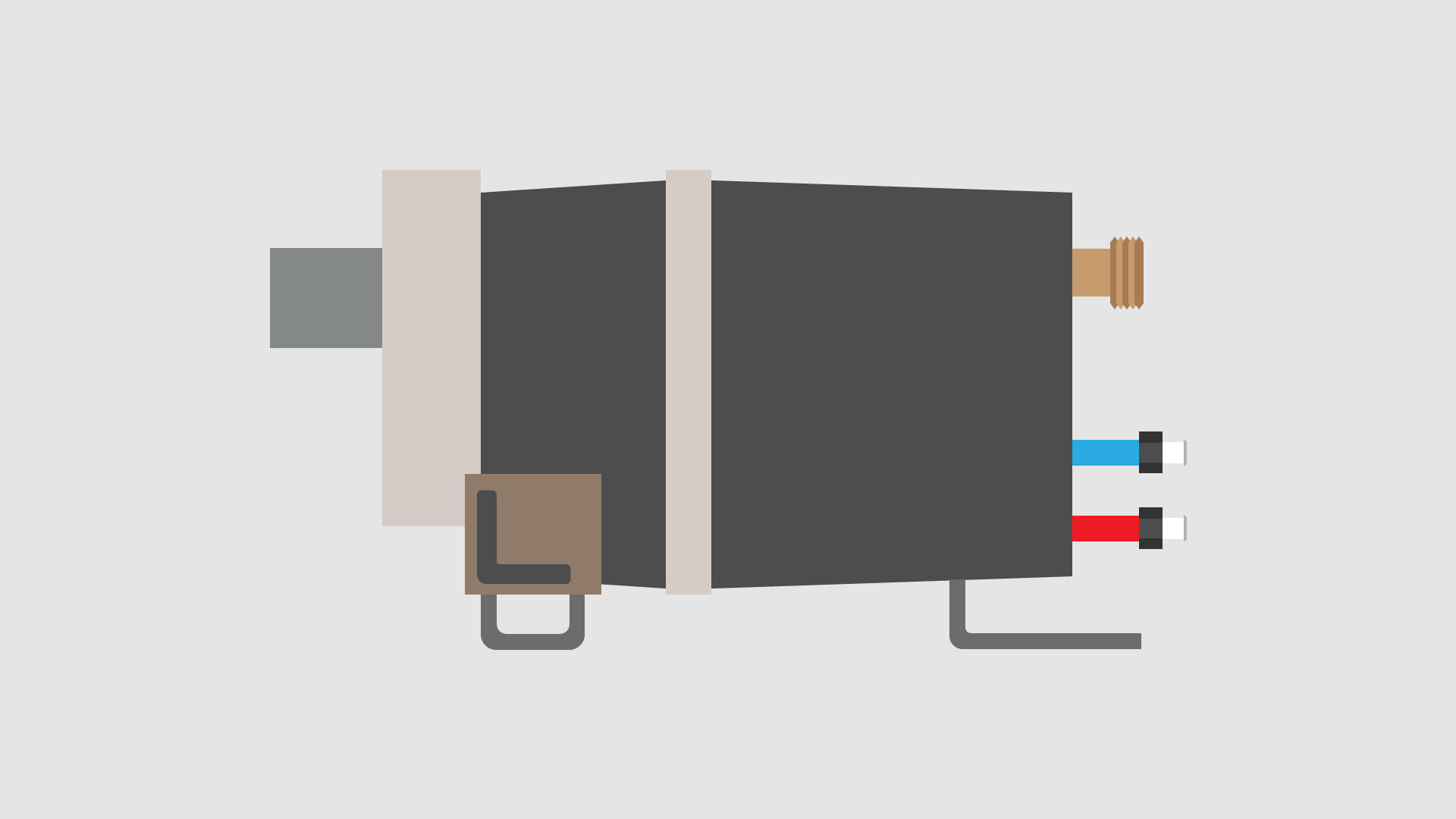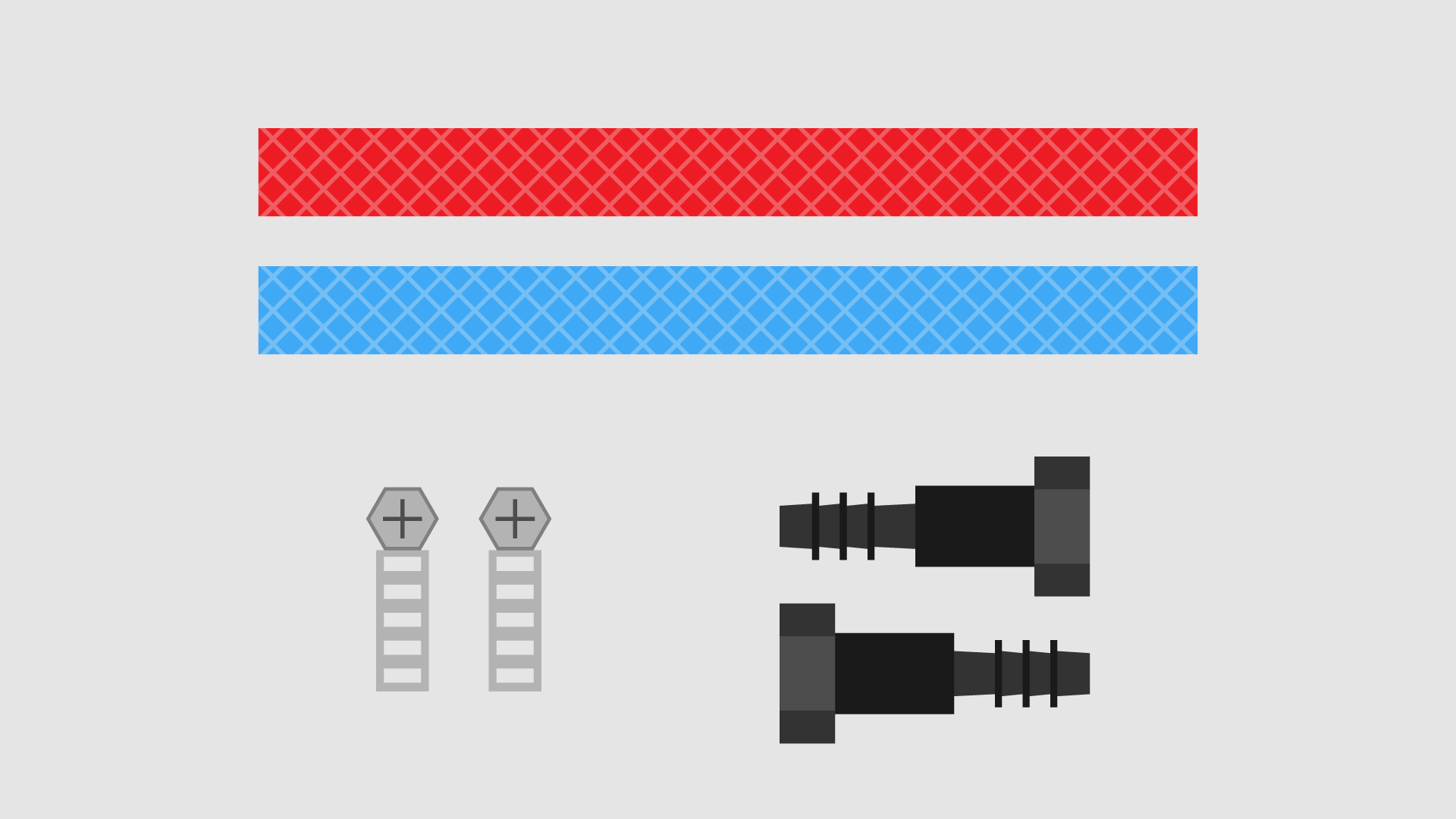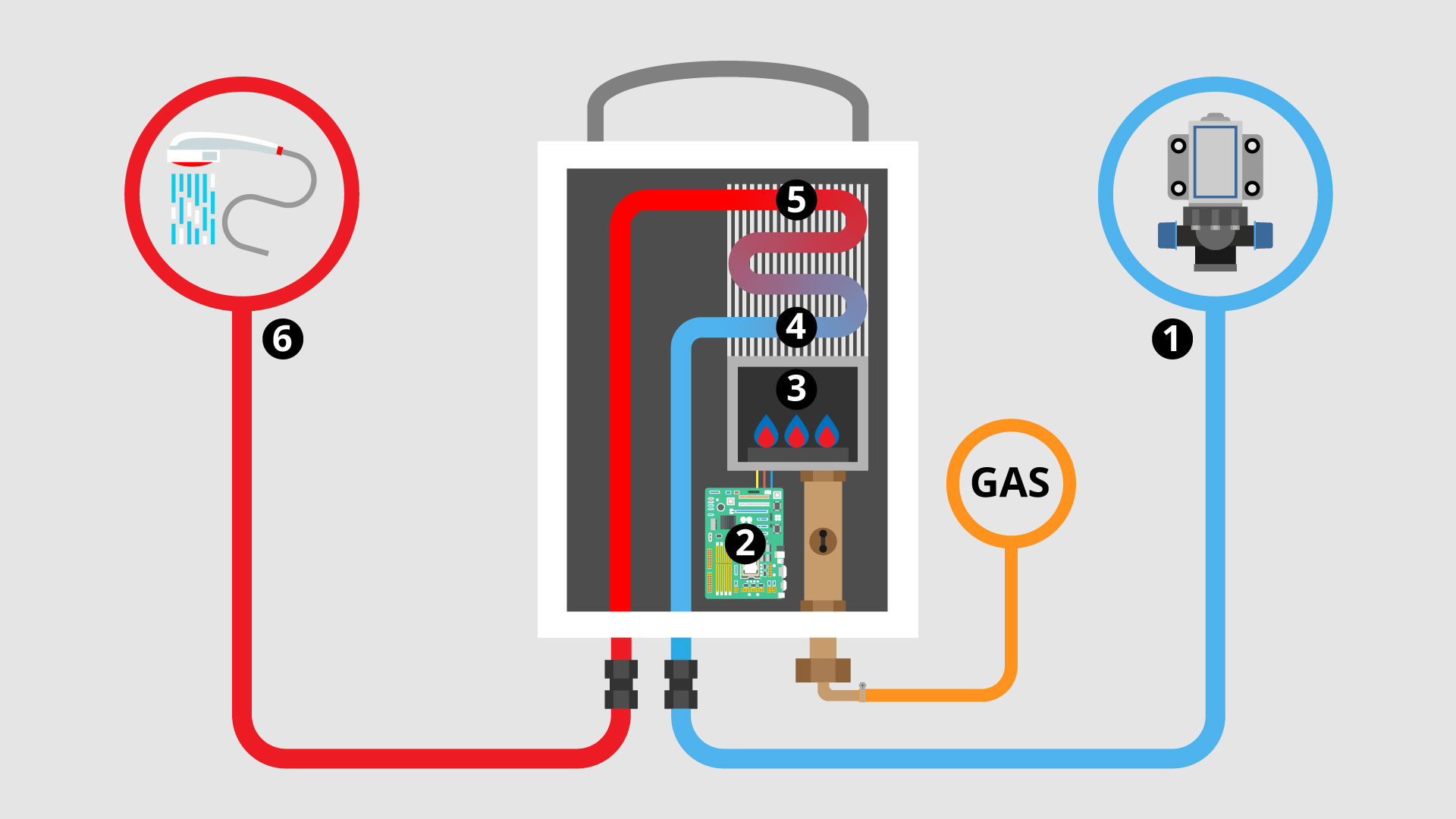- Arron
- Updated: 25th February 2023

Having water aboard your campervan is an essential addition that makes travelling in a campervan an enjoyable experience.
Whether you need water for drinking, cooking, or for taking a shower, having a steady supply of fresh water is an excellent addition to any campervan conversion.
The water system found aboard a typical campervan is split into three categories.
Those systems are:
- Blue Water System – (Fresh Water)
- Grey Water System – (Non-Sewage Waste Water)
- Black Water System – (Sewage Waste Water)
Blue Water System

What is A Blue Water System?
A Blue Water system aboard a campervan is classified as the fresh water system. This is generally for the water you’ll use for most scenarios in your campervan. Water used for drinking, cooking, washing pots, and taking a shower is supplied from the blue water system.
Blue Water System Components
As your blue water system handles water that will be used for human consumption, all blue water components should be constructed out of food-safe materials. Below, we have broken a blue water system into the four main categories.
1. Water Storage
The first part of a blue water system is water storage. Having an efficient water system onboard your campervan will obviously require a practical way to store the water.
What should I look out for when buying a water tank?
Size (Capacity)
Look for a tank that will hold enough water for at least three days worth of use. If you choose a tank that is too small, and you’ll be constantly stopping to refill. On the other hand, choose a tank too big, and you may affect your vehicle handling.
Durability
- Durable. The last thing you want is a water leak aboard your campervan. Try and choose a water tank that is sufficiently durable while in transit. You’ll need a tank that has sufficient reinforcement that can handle the extra stress of moving.
When it comes to selecting the correct type of water tank, you have two options to choose from.
Water Tank Configurations
Option 1 – Detachable Fresh Water Tank

The most basic water storage solution in a campervan is a detachable fresh water tank. A detachable fresh water tank comes in a range of sizes and is generally stored inside your campervan. Small in size, they’re a quick and easy low-cost solution for storing water aboard your campervan while travelling.
Advantages of a detachable fresh water tank
- As the tank can be removed, you don’t need to manoeuvre your campervan close to a water filling point.
- Can fill up at any water outlet.
- Cleaning the tank is a simple process.
- Low-cost setup.
- No special equipment required to calculate fill level – simply look at the tank (if translucent) or open the cap and look inside.
Disadvantages of a detachable fresh water tank
- If you plan on using your campervan water system regularly, a detachable fresh water tank may not be the most practical solution.
- Small storage capacity. You’ll have to make frequent stops to refill the tank. Furthermore, if you plan on installing a shower, a detachable water tank will not hold enough water.
- When refilling – carrying a full tank of water back to your campervan could be a little strenuous – even more so if transporting over a long distance and/or up a flight of stairs.
- Will require the use of internal space.
What We Think
A detachable water tank system is a brilliant way of storing water aboard your campervan if you only plan on using a minimal amount of water while travelling. Having to frequently stop and search for a tap just to refill your water tanks can soon become tedious. Having said that, a detachable fresh water tank is still an excellent, cost-effective water storage solution.
Detachable Fresh Water Tanks We Recommend
Water tanks are water tanks. All popular online retailers stock a huge variety of water tanks that will suit your campervan conversion project.
Here we’ve listed what we believe are the best value for money detachable water tanks.
Alternatively, check out Amazon:
[/su_box]
Option 2 – Fixed Fresh Water Tank

As the name suggests, a fixed tank is securely attached to your vehicle. It can be installed both internally and/or externally to your campervan. A fixed water tank is going to offer you the highest capacity for storing water in a campervan.
Advantages of a fixed fresh water tank
- More of a ‘professional’ install.
- Offers the best water storage capacity.
- Can be installed on the underside of your campervan. If you choose this option, you’ll save valuable internal space.
- A wide variety of size configurations available. This will give you the option to find the perfect size that will fit efficiently for your specific requirements.
- Extremely durable.
Disadvantages of a fixed fresh water tank
- More of a ‘professional’ install – yes, we mentioned this as an advantage, but this means you may need to hire a plumber and/or vehicle body shop to install the tank and fittings.
- You might have to modify your van body (cut into the panels) to install a water filling point.
- Will require a water level gauge if you would like to accurately calculate how much fresh water is in the tank.
- Depending on where you have installed the tank, it may be a challenge to clean.
- Having the option to store a more considerable amount of water means once the tanks are full, your campervan will increase in weight. This may harm fuel consumption or take your campervan over its maximum gross weight.
- You have to position your campervan within reaching distance to refill the tanks.
- You have to carry additional equipment that is used to refill the water tank (hose, connection adapters).
- Most expensive option out of the two.
What We Think
We feel that the best solution for storing your fresh water aboard your campervan is with a fixed tank over a detachable one. Having the option to store a large volume of water while on the road is invaluable – especially if you like to take a shower more frequently.
Fixed Fresh Water Tanks We Recommend
As every campervan conversion is going to be different, the size of the container will ultimately come down to your preference.
We suggest you carry out a detailed search on Amazon to find the best fresh water tank that will fit your individual requirements.
Make sure to choose a tank that is constructed out of non-toxic/B.P.A. free materials.
Exclusive Offer
Water Pump
Once you have a practical way of storing fresh water aboard your campervan, you’ll now need a method of getting that water back out of your tanks when required. To do this, you’ll require a water pump.
In nearly all conventional campervan conversion, there are three different methods on how to pump fresh water around your system.
Method 1 – Manual Water Pump
The simplest method to move water through your system is via a manual water pump. The most popular models have a plunger built directly into the tap. Simply pump up and down to commence water flow.
Advantages of a manual water pump
- Super simple – pump plunger, get water!
- Does not require electricity.
- Low cost.
- Quiet.
- Reliable.
Disadvantages of a manual water pump
- May get a bit strenuous if you need to pump a lot of water. (Although you might develop some Arnie arms!)
What We Think
If you’re after the most straightforward campervan water pumping solution, then this is your option. This might be useful for people who only require their campervan water supply on rare occasions – or people who love to work out 24/7!
Method 2 – Submersible Water Pump
As the name indicates, a submersible pump is submerged inside your freshwater tank to provide a steady supply of water. The pump is operated via an external 12-volt power supply that connects to an external switch. Typically, you would position the switch close to the water outlet.
However, the most common operation method is via a specially developed tap with an integrated micro-switch. When the tap is opened, the switch activates the submersible water pump which will now begin to pump your water. To stop the pump, simply shut off the tap.
What We Think
If you’re after a super simple automatic freshwater setup, a submersible pump pared with an external switch is an excellent way of providing a steady flow of water.
If you do go with this setup, we suggest you choose the specially developed tap over the external switch.
Submersible Water Pumps We Recommend
Integrated Tap and Switch We Recommend
Method 3 – External Pressure Sensitive Water Pump
A pressure-sensitive pump is a water pump with an integral pressure switch. When you first activate the device, the pump will slightly pressurise the whole freshwater system.
Once an outlet is opened in the system, the pressure switch built into the device will detect the drop in pressure and instantly activate the water pump. Once you close the outlet, the pressure switch will detect pressure returning to normal and will shut off the pump.
Advantages of a Pressure Sensitive Water Pump
- Fully automatic and self-priming.
- Low amp draw.
- Capable of running dry without damage.
- Quiet when operating.
- Robust and reliable.
Disadvantages of a Pressure Sensitive Water Pump
- Most expensive water pump device.
- Hard to service.
- If a leak develops, the pump will run until all the water has been discharged from the water tank.
What We Think
Considered to be the best option on the market, a pressure-sensitive water pump is a very efficient way of pumping water around your campervan.
With little power use, quiet operation, and superior reliability, we feel installing this type of pump is the best method for most applications.
Pressure Sensitive Water Pump Pumps We Recommend
Here we have listed what we believe to be the very best pressure sensitive water pumps you can buy.
Water Heaters
So now you have a way to store and pump water around your campervan, next on the list is usually adding a system to heat your water. Whether you need hot water for washing up dirty dishes, or for taking a hot shower, installing an efficient system to heat up your water is a little luxury worth having.
How do I heat the water in my campervan?
The two most common methods for heating water in a campervan are as follows:
Method 1 – Tankless Water Heater (LPG)

The first option to heat water in a campervan is a relative newcomer to the campervan conversion market.
Very similar to a gas boiler you would typically find inside a home, an LPG tankless water heater gives you on-demand hot water via an internal gas burner connected to a heat exchange system. Extremely safe, relatively inexpensive, and compact enough not to take up much room inside your campervan, an LPG water heater is an excellent way of creating that all-important hot water.
The only issue you may have with an LPG water heater is that this system requires the use of natural gas.
Therefore, you’ll have to have in place a gas storage system aboard your campervan. You’ll also have to install a vent above your heater to the outside. This is to expel gasses coming off the LPG water heater.
How does an LPG Water Heater Work?
Generally, an LPG water heater has 3 pipe connections.
One is the cold-water inlet feed, the other is the hot water return feed, and the final connection is the gas supply line.
- When you first open a hot water outlet, your water pump will detect the drop in pressure. It will begin to pump water through the LPG water heater.
- A smart controller located inside the LPG water heater detects water is flowing through the heater
- It will now automatically open the internal gas vent and ignite the burner.
- The heat created from the burner spreads to the adjacent heat exchanger.
- The water circulates around the heat exchanger, where it increases in temperature.
- The now hot water finally leaves the LPG water heater to the open water outlet.
How long does it take to have hot water?
Depending on the model, It takes approximately 5 – 15 seconds for the water heater to get the water to an adequate temperature.
Advantages of an LPG Water Heater
- On-demand hot water.
- Extremely safe – If the LPG water heater fails to light within a few seconds, the internal ECU shuts down the gas flow. This prevents any unsafe accumulation of gas.
- Automatic operation.
- Relatively inexpensive.
Disadvantages of an LPG Water Heater
- Requires gas. You may need to install a gas storage system aboard your campervan.
- The LPG heater needs to be installed correctly. There should be sufficient room for the unit to operate as well as unobstructed flu connected to an exterior vent to exhaust all combustion gasses.
What We Think
An LPG water heater, in our opinion, is one of the best ways you can heat up water aboard your campervan.
They’re safe, give you an endless supply of on-demand hot water (obviously depending on how much water/gas you have), and they take up minimal space.
They’re also extremely efficient, super safe and very reliable.
LPG Water Heaters We Recommend
After an extensive search around the web, contacting manufacturers directly, and asking current owners; here’s what we believe are the best models you can purchase right now.
All models featured come with an official certificate of safety, a C.E. mark, as well as a well documented easy to read operating manual.
Method 2 – Water Boiler (Gas/Electric/Dual-Fuel)

Available in either gas or electric-only variants, as well as a dual-fuel model (a combination of both gas and mains power), a water boiler is a device that efficiently heats your campervan water.
Depending on the model you choose, located inside the unit is either a powerful gas burner, an electrical heating element, or both.
Individually, each heating element increases the temperature of the water inside the internal tank, ready for when required.
Many models feature excellent heat insulation inside the unit. This ensures that there is little heat lost once the water has reached the desired temperature.
How long does it take to heat up water?
On average, a single fuel unit takes approximately 30 minutes to heat water from 15 °C to 70 °C.
The dual-fuel model combines both gas and electric heating elements. As a result, the water boiler approximately cuts the total time to heat the water in half. (around 15 minutes)
Advantages of a Water Boiler
- You can run this boiler directly of the mains power. But, this would mean you need to be connected to the grid.
- As the boiler has an internal tank, this will increase the total water-storage capacity aboard your campervan.
- Extremely reliable.
- A well-documented track record for safety.
Disadvantages of a Water Boiler
- Can take a while to heat the water. The average wait time is approximately 30 minutes to heat 7 to 10 litres of water.
- Slightly expensive for what they do.
- Big and bulky. Will require using internal space.
[su_box title=”What We Think” box_color=”#00568e” title_color=”#ffffff” radius=”0″]
For many years, a water boiler was the ‘go-to’ water heater for both professional and D.I.Y. campervan builds.
But, since the introduction of L.P.G. heaters that can supply on-demand hot water at a fraction of the cost, a modern-day water boiler is now struggling to be a viable option.
But we’re not saying a water boiler has no uses.
We think this type of water heating method is brilliant for people who frequently stay in locations that have access to shore power (240v/110v).
This means you don’t have to install a separate gas storage system just to run this heater.
And talking about gas; there’s also the safety aspect – some people simply don’t like travelling with compressed gas aboard their campervan.
As you can get a water boiler that runs of mains only, this is a perfect compromise.
Water Boilers We Recommend
Europe
The two major European water boiler manufacturers are Trauma and Propex.
North America
- Suburban Manufacturing 5239A Water Heater (6 Gal Capacity)
- Suburban Manufacturing 5243A Water Boiler (10 Gal capacity)
Australia
- Suburban Manufacturing 5239A Water Boiler (6 Gal capacity)
- Suburban Manufacturing 5243A Water Boiler (10 Gal capacity)
Additional Blue Water Parts
Surge Damper

A surge damper is an intelligent device that reduces pulsations as well as noise coming from your water pump.
The device is connected directly on the outlet side of your water pump.
When operational, the surge damper will help create a smooth continuous flow of water.
Surge Dampers We Recommend
Inline Contaminants Filter

An inline contaminants filter is a handy device that prevents unwanted debris and other particles entering your water pump.
The filter screws directly to the inlet housing of your water pump.
The translucent filter housing gives you the ability to easily see when the filter requires cleaning.
Inline Contaminant Filters We Recommend
Pipes and Fittings

Pipes and fittings are the backbones of your blue water system. They are responsible for transporting all the fresh water around your campervan.
When it comes to what type of piping to use, some installers chose flexible food-grade hosing. In contrast, others prefer to use the more durable push-fit systems.
When it comes to choosing the right product, this is entirely down to you.
Pipes and Fittings we Recommend
Flexible Hose
Push-fit
Water Inlet

Similar to a fuel filling inlet you would typically find on your campervan, a water inlet is a device that’s installed to the body of your campervan.
At the rear of the inlet is a large hose connection.
Here, you attach a pipe that then connects directly to your water storage tank system.
This device makes it very easy to refill your internal water tanks.
Some come with special hose connections that give you a secure fit when topping up water.
Water Inlets We Recommend

Related Reading
- Campervan Split Charging: A helpful illustrated guide
- Top 5 Campervan Roof Vents in 2020
- Campervan Ventilation: A Useful Guide
Grey and Black Water System (Wastewater)
Every blue water system aboard a campervan is no doubt, going to produce wastewater.
Wastewater is going to be produced every time you do the washing up, take a long hot shower, or use the toilet.
You’ll need the correct systems in place to manage all wastewater you create so you can store then eject it from your campervan using the correct procedure.
Wastewater systems fitted to a campervan are split into two individual systems.
What are the two different types of wastewater systems on a campervan?
Grey Water System

What Is A Grey Water system?
A grey water system is a network of waste pipes running through your campervan, along with a holding tank located on the underside of your campervan.
Its sole responsibility is for the handling of polluted water which has not come into contact with urine and faecal matter.
How is Grey Water Produced?
Grey water is wastewater that is produced when taking a shower or washing dirty dishes.
Do I need a grey water system?
If you plan to install a blue water system aboard your campervan for the sole purpose of drinking the water, you’ll more than likely not require a grey water system.
If you plan to use your blue water for additional washing (taking a shower, washing dirty dishes), then you’ll undoubtedly produce wastewater.
You’ll then have to install a grey water system to collect all wastewater until you can eject it correctly from your vehicle.
Black Water System

What is A Black Water System?
A black water system is a network of waste pipes – along with a holding tank, located in a campervan.
Its sole responsibility is for the safe handling of polluted water which has come into contact with urine and faecal matter.
How is black water produced?
Black water is wastewater produced after the use of a toilet.
Do I need a black water system?
You’ll only need to install a black water system if you plan to install a lavatory system that requires a separate black water storage system.
Many portable toilet models come with an independent blue and black water systems built directly into the toilet itself.
Can’t I just dump my black water directly outside?
I’m sure this goes without saying but dumping raw sewage (black water) directly outside is highly illegal (and improper) in many countries around the world.
Where do I empty my black water tank?
Many campsites have individual facilities where you can empty your black water tank.
Waste System Components
As grey and black water systems both handle wastewater, they use the same type of components.
Wastewater Storage
Fixed Waste Storage Tanks

Mobile Waste Storage Tanks

Additional Waste Components
Waste Pipe and Fittings

Waste Release Tap

Campervan Water Frequently Asked Questions
How much water does a campervan hold?
The amount of water a campervan will hold depends on the size of the freshwater storage tanks. The average holding capacity of a fixed freshwater tank is between 60 litres to 140.
How much water each day will I use in my campervan?
This can only really be calculated on a per-use case scenario.
On average, a human has a shower for 8 minutes and 20 seconds. The average water pump pumps water at around 7 litres per minute. Using these calculations, an average person will use approximately 57.4 litres of water every time they take a shower. In addition, washing pots will use around 20 litres of water.
If you were to do those two activities every day, you would around 77 to 80 litres of water every day.
However, it is worth noting that when you travel in a campervan, you obviously change the way you live. Those 8 minute daily showers, soon become 4-minute ‘once every 3-day ‘ showers.
Did you find this guide useful?
Thank you for reading our highly detailed guide! We hope it was informative and helpful. If you enjoyed the content and found it useful, we would greatly appreciate it if you could leave a quick review to let us know your thoughts. Your feedback helps us improve and continue creating valuable content for our readers. Alternatively, if you feel inclined, you could also support us with a small donation. As a small independent website, every contribution helps us continue our work and keep creating quality content. Thank you for your support!
The whole process takes less than 60 seconds and directly supports VanLife Adventure.
Disclaimer
VanLife Adventure has made every effort to make sure all information displayed on this website is correct and valid. However, neither VanLife Adventure nor its employees warrants or accepts any liability for the use of any of the information presented here. The user is cautioned to seek competent engineering assistance when carrying out any installations.
- Share
- Like
- Tweet
- Pin
- Digg
- Del
- Tumblr
- VKontakte
- Buffer
- Love This
- Odnoklassniki
- Meneame
- Blogger
- Amazon
- Yahoo Mail
- Gmail
- AOL
- Newsvine
- HackerNews
- Evernote
- MySpace
- Mail.ru
- Viadeo
- Line
- Comments
- Yummly
- SMS
- Viber
- Telegram
- Subscribe
- Skype
- Facebook Messenger
- Kakao
- LiveJournal
- Yammer
- Edgar
- Fintel
- Mix
- Instapaper
- Copy Link























